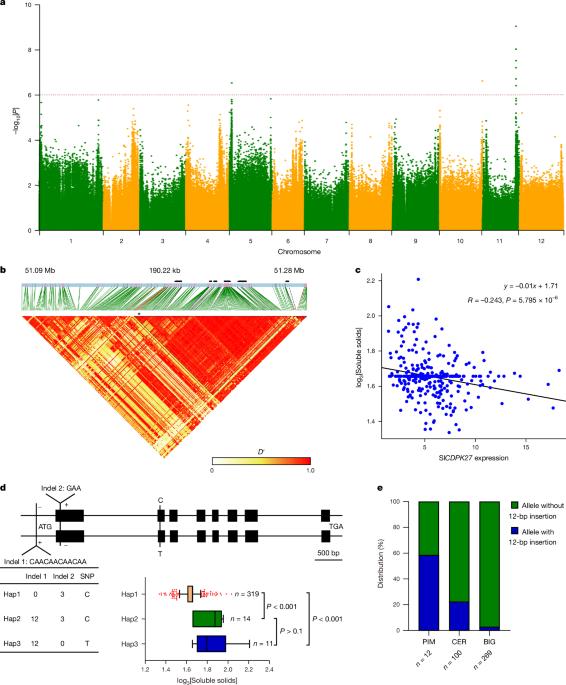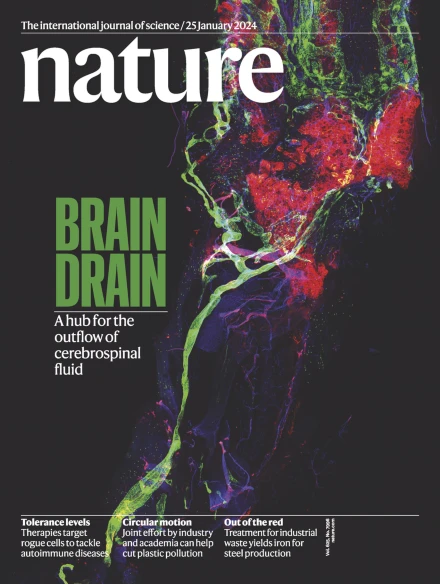Releasing a sugar brake generates sweeter tomato without yield penalty
IF 48.5
1区 综合性期刊
Q1 MULTIDISCIPLINARY SCIENCES
引用次数: 0
Abstract
In tomato, sugar content is highly correlated with consumer preferences, with most consumers preferring sweeter fruit1–4. However, the sugar content of commercial varieties is generally low, as it is inversely correlated with fruit size, and growers prioritize yield over flavour quality5–7. Here we identified two genes, tomato (Solanum lycopersicum) calcium-dependent protein kinase 27 (SlCDPK27; also known as SlCPK27) and its paralogue SlCDPK26, that control fruit sugar content. They act as sugar brakes by phosphorylating a sucrose synthase, which promotes degradation of the sucrose synthase. Gene-edited SlCDPK27 and SlCDPK26 knockouts increased glucose and fructose contents by up to 30%, enhancing perceived sweetness without fruit weight or yield penalty. Although there are fewer, lighter seeds in the mutants, they exhibit normal germination. Together, these findings provide insight into the regulatory mechanisms controlling fruit sugar accumulation in tomato and offer opportunities to increase sugar content in large-fruited cultivars without sacrificing size and yield. A study identifies two genes that act as brakes controlling the sugar content of tomatoes and demonstrates their manipulation to generate sweeter tomatoes without affecting the fruit size and yield.


释放糖分制动器可使番茄更甜,而不会影响产量
番茄的含糖量与消费者的喜好高度相关,大多数消费者喜欢更甜的水果1,2,3,4。然而,商业品种的含糖量普遍较低,因为它与果实大小成反比,而且种植者优先考虑的是产量而不是风味质量5,6,7。在这里,我们发现了两个控制果实含糖量的基因,即番茄(Solanum lycopersicum)钙依赖性蛋白激酶 27(SlCDPK27;又称 SlCPK27)及其同源物 SlCDPK26。它们通过磷酸化蔗糖合成酶,促进蔗糖合成酶的降解,从而起到糖制动器的作用。基因编辑的 SlCDPK27 和 SlCDPK26 基因敲除可使葡萄糖和果糖含量增加多达 30%,在不影响果实重量或产量的情况下提高甜度。虽然突变体中的种子数量较少、重量较轻,但它们的萌发正常。总之,这些研究结果使人们对控制番茄果实糖分积累的调控机制有了深入了解,并为在不牺牲果实大小和产量的情况下提高大果栽培品种的糖分含量提供了机会。
本文章由计算机程序翻译,如有差异,请以英文原文为准。
求助全文
约1分钟内获得全文
求助全文
来源期刊

Nature
综合性期刊-综合性期刊
CiteScore
90.00
自引率
1.20%
发文量
3652
审稿时长
3 months
期刊介绍:
Nature is a prestigious international journal that publishes peer-reviewed research in various scientific and technological fields. The selection of articles is based on criteria such as originality, importance, interdisciplinary relevance, timeliness, accessibility, elegance, and surprising conclusions. In addition to showcasing significant scientific advances, Nature delivers rapid, authoritative, insightful news, and interpretation of current and upcoming trends impacting science, scientists, and the broader public. The journal serves a dual purpose: firstly, to promptly share noteworthy scientific advances and foster discussions among scientists, and secondly, to ensure the swift dissemination of scientific results globally, emphasizing their significance for knowledge, culture, and daily life.
 求助内容:
求助内容: 应助结果提醒方式:
应助结果提醒方式:


